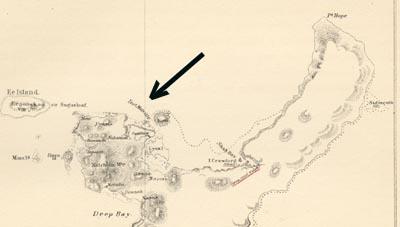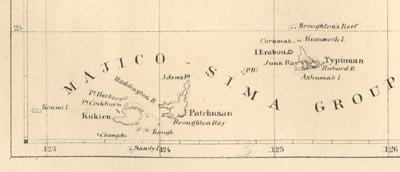Aaron Haight Palmer Letter, 1849
Urging the Japan Expedition
Palmer, Aaron Haight:
Letter to the Hon. John M. Clayton, Secretary of State, Enclosing A Paper, Geographical, Political, and Commercial, on the Independent Oriental Nations; and Submitting a Plan for Opening, Extending, and Protecting American Commerce in the East, &c: Respectfully Submitted to the President and Cabinet, By Aaron Haight Palmer, Counsellor of the Supreme Court of the U.S. -- Published by Direction of the Department of State in the National Intelligencer of the 6th September, 1849. Revised, and Now Republished with an Appendix, Washington, Gideon & Co., Printers, 1849, large 12mo (5 1/2 x 8 1/2 in), 63 pp.
This is a letter dated April 14, 1849 from Palmer to the Secretary of State. An appendix with supplemental information has been added, apparently by the Department of State. In his letter, Palmer urges that the United States initiate broad ranging initiatives to facilitate trade with the "Independent Maritime Commercial Nations of the East." The countries include "Japan and it's colonial dependencies" among many others.
Palmer devoted more of his attention to Japan than any other country. He described Japan as the "... isolated and mysterious empire of Japan, which has been, since 1637, hermetically sealed to all foreign intercourse and trade, except with the Chinese and Dutch...." He believed that Japan had "inexhaustible mines of precious metal...." He felt the same was the case with coal. Palmer was concerned by the treatment of distressed American whalers noting that they were being mistreated in Japan and sometimes executed. He urged this matter be resoled immediately and if the Japanese refused to remedy the situation that the Bay of Yedo and Port of Matsmai be blocked. He calculated that two frigates could carry out such a blockade.
While concerned with mistreatment of Americans, it is clear the main focus of Palmer's concern was commerce. He urged that trading concessions be sought with Japan and that a special envoy or commissioner be sent to Yedo to "obtain an authentic record of such concession...." He believed that this mission should be assigned to an "armed steamer" and stated that several experienced naval officers, including Commodore Perry, agreed with this recommendation.
Palmer also discussed the plans for construction of a transcontinental railroad from St. Louis or Michigan to San Francisco or San Diego. This would tie the US east coast with the Far East through the train and Pacific steamer routes. He noted with such a transportation network, travel from Shanghai to New York could be completed in 25 days and to London 35 days.
Palmer gave special attention the role the Loo Choo islands would play in these terms:
The Loo Choo Islands would be excellent places of resort for American whalers in want of refreshments or repairs, and where a coaling depot could be established for our steamers in the Japan seas. Port Melville, called by the natives Outing or Vouching, situated on a bay of the same name, on the western coast of Great Loo Choo, is a safer port than Napakiang (Naha), and capable of receiving ships of the largest size. The bay is two miles in extent, protected from all winds, and affords peculiar advantages and facilities for careening and refitting vessels, so much wanted in those seas. At its entrance is a high conical mountain, called by the natives Egouchkotind, or "the Castle," a prominent land mark, visible 25 miles at sea. The connexion between Loo Choo and China first commenced in 1372, and is merely nominal and ceremonial. The junks conducting the tribute have free access to Fuchau, and all the goods they export and import are free of duty. At Shudi, the capital, a college is established for the education of the upper classes, in which the Court dialect of China is taught, and is the medium of official correspondence with strangers. The subjection of those islands to Japanese rule began by conquest in 1609.
The MEIA-CO-SIMA, or "Eight Islands," called in the old chart the Hajicosima Group, have been surveyed by Captain Belcher, and are found to possess several good harbors and anchorages. They are inhabited by an intelligent, mild, and inoffensive people, evidently of the same race as the Loo Chooans, and are governed by chiefs appointed by the Prince of Great Loo Choo, to whom they pay an annual tribute. The islands are represented to be fertile, and under tolerable cultivation. The variety and beauty of the vegetation clothing the sides of the mountain of Pa-tchan-san and its neighbor, are represented by Captain Belcher to be very striking. (at page 15)
The appendix which is added to the original letter contains various documents containing information on Japan, China and other countries in that area. The Japan section is extensive and covers pages 38-57.
In my opinion, the Palmer letter is the earliest and most comprehensive public discourse on opening trade with Japan and how that could accomplished. It also places that undertaking in the historical context of westward expansion and development of the United States. Ultimately, the steamship routes to Japan and the Far East and the transcontinental railroad would greatly facilitate trade and commerce with Japan and the entire Far East, just as Palmer envisioned in his letter.
Postscript regarding Loo Coo.
Palmer suggested two places in the Loo Choo (Ryukyu) Islands as locations for potential ports/anchorages for American ships. The first was Meia-co-shima (Miyako). The other was Port Melville on Okinawa proper. Palmer's letter does not contain maps or illustrations. Below are maps which were published in the Narrative of the Perry Expedition published by the Government in 1856 which show both locations.
"Port Melville - Great Loo Choo"

"Meia-co-shima" - Miyako Islands

|

